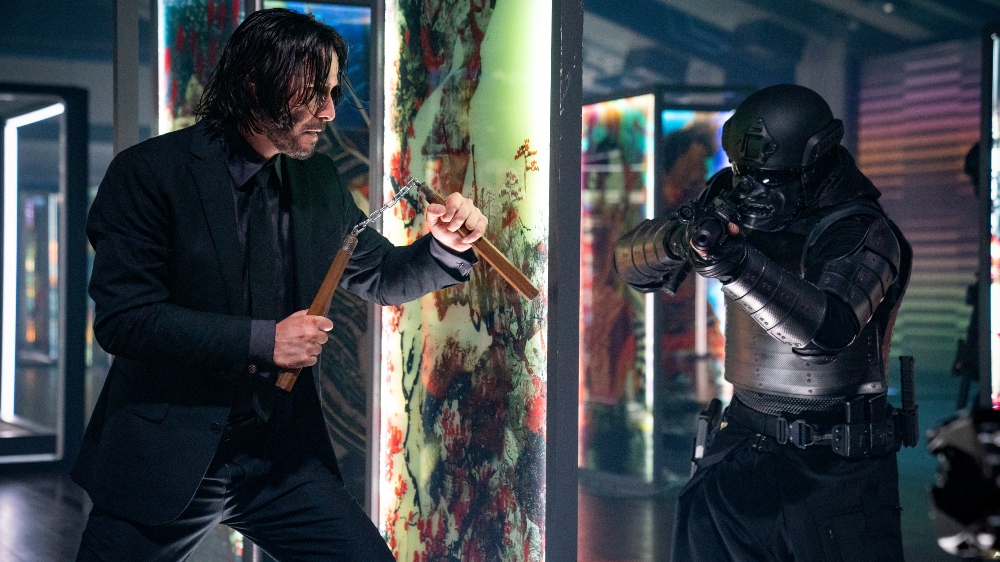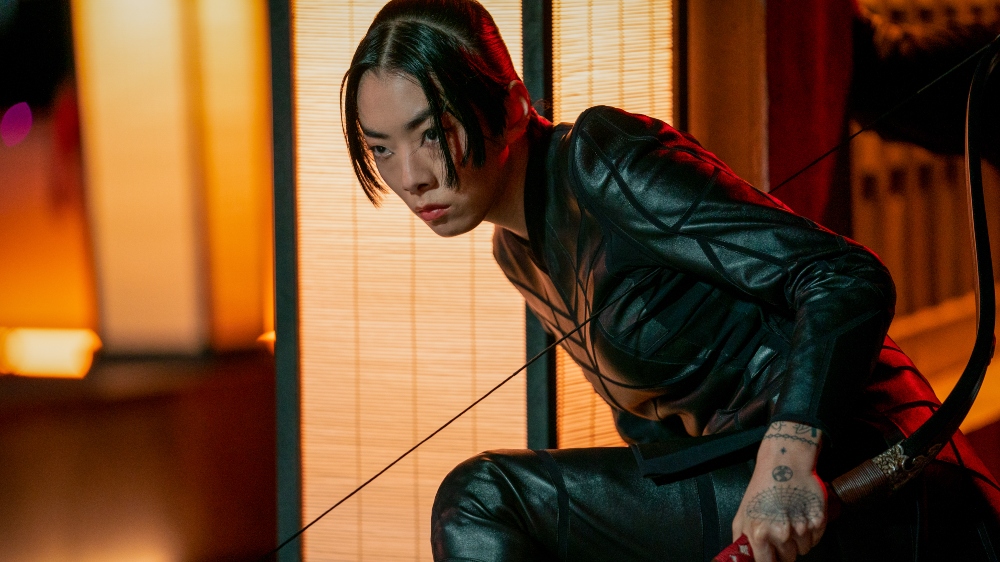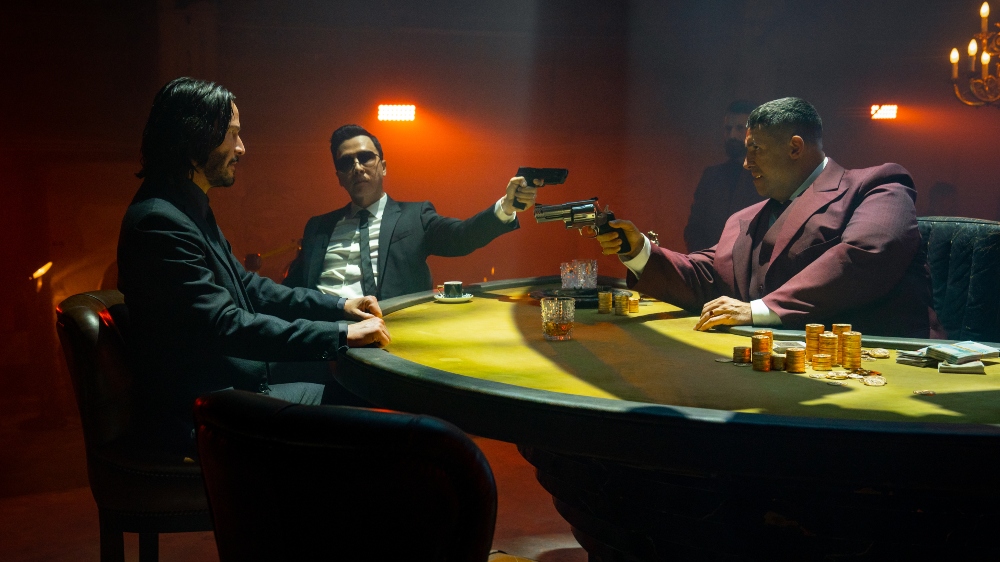
Mark Stoeckinger has been the supervising sound editor on all four films in the vaunted John Wick action franchise. The most recent entry, John Wick: Chapter 4, provided him with the biggest canvas yet to create a sonic tapestry as exotic and expansive as the criminal underworld created by director Chad Stahelski.
We got to speak with three-time Oscar nominated sound editor Stoeckinger about some of the challenges and fun of this latest installment in the ever-evolving Wick saga.
Below the Line: Could you to very briefly explain -in your own words- your job of a supervising sound editor?
Mark Stoeckinger: I’ll explain it the way I see it, because I think everybody approaches the job differently, and every film has different requirements. Basically, my job is to work with the filmmakers — to me, that’s the director, obviously, and frequently the picture editor as well — and take their vision, the story they’re trying to tell, and make the sound the best representative as it can be to do that.
In the process to doing that, I have quite a few really talented people… sometimes there’s an army of me, sometimes it’s an army of quite a few people: somebody that oversees all the ADR for all the extra dialogue, a foley team — which is pivotal to a film like John Wick– and then sound creators, sound designers, and people who work with the production dialogue… to try to make that as cohesive as possible. I oversee that team, and all the creativity and all the work that they do, and make sure it gets to the next stage to represent the ideas and work with the re-recording mixers to get the final track that we all want.
BTL: What was the most challenging aspect or sequence of this fourth installment for you? Do you have an idea of what shot had the most elements underneath it in the editing timeline?
Mark Stoeckinger: The amount of sound in this movie… this movie was the equivalent of two John Wick movies. There was so much going on. There’s a lot of fights, a lot of gunshots, car chases, all that, but so much of it is beyond that. It’s the environments, it’s the texture, it’s the location.
One of the first sound notes that Chad gave me wasn’t about a gun or a car or anything like that. He goes, “We shot this in some amazing locations. I want the sound to represent and elevate those locations as much as possible. I want each space to have its own unique signature, particularly through the use of different kinds of reverbs.” First time he’s ever given a note like that, and he’s been in some pretty outlandish locations before.
Texture and detail is really the first task of John Wick. It’s not about the fights and the guns and the cars because we have confidence we’re going to do a really great job on those and find new ways and make it more articulate and detailed and not noisy but impactful. But it’s the spaces themselves that you want to have a unique character. John Wick is famous for taking his time and walking, and that gives us an opportunity to create a space, put the reverb on the footsteps. Winston walking through the Louvre is a classic example of that, or John in the churches. Those are the situations that allow us to hopefully satisfy what Chad’s looking for because that’s something you hear and that’s something we feel.
Another important part of the John Wick series is non-literal sounds in backgrounds that could be construed as music, but they can be tonal. Where Charon and Winston first meet the Marquee there’s this very low frequency tone, which is very unsettling because we know it’s an unsettling scene. We want to make the most of that in the sound we put in. Or there’s the scene with John and Caine. Obviously, with our blind assassin every little sound cue is important to that storytelling. Music would not have been appropriate to play, but we were able to make the sound that was like Buddhist monks chanting slowed down, some of it in reverse and on top of each other with reverb. That created this almost church-like space that seemed appropriate to that scene. When Hiro and Kane are having their fight on the rooftop of the Continental, that was made as quiet as possible. You’ve got the calmness of wind chimes and water in the waterfall and the leaves and trees to counterpoint with the violence that’s happening in the scene.
Those are some of the sound moments that we find pretty delectable because it allows for a lot more experimentation. Chad would say, “What’s the sound of somebody getting whacked with a nunchuck?” Actually, I bet Chad knows in real life from his martial arts background, but you know what it sounds like in real life. Who knows what it’s going to sound like in a movie? I think I got an idea. There’s some metal rods hitting a pig’s head somebody did on a Foley stage once, which is part of the elements, like chain snaps and whooshes and the little details that add up to something that’s pretty interesting and violent at the same time. Because we are always looking to hurt whoever gets hurt, I think that’s part of the John Wick lore, in a way.

BTL: When Sergio Leone was making his Westerns, critics commented that the guns sounded like cannons and the cannons sounded like atomic bombs. Were there specific creative licenses you took with certain sounds in John Wick 4?
Mark Stoeckinger: You always want to make the guns sound interesting and impactful. Fortunately, we play them loud because anybody who’s been around a real gun knows they are loud, and when you don’t play them that way you feel cheated. That would be very cheating in a John Wick movie. But the most unique gun we had in this movie was that Dragon’s Breath shotgun. Of course I go on YouTube and listen to what a Dragon’s Breath sounds like… it sounds like a weak shotgun, doesn’t even sound like a good shotgun. There’s no clues as to what that’s going to sound like in John Wick, so let’s go make it a fire breathing dragon. There is some fire breathing dragon subtext to those sounds. You look for opportunities like that to play.
Take the western part of the duel at the end. One begins to sound like black powder. They’re not, but that’s a stereotypical sound. We wanted that to be a dusty windy street like High Noon because it’s a Western. Not because that’s realistic at all, but because that’s what the scene deserves. For all of us working on the John Wick franchise, there’s always an homage to something everywhere. We have our homage to Lawrence of Arabia, the beginning shot exactly where Lawrence of Arabia was shot in the desert, with the elder from the high table standing exactly where Peter O’Toole stood.
Sonically, we get to pay attention to that and have fun with it. It’s not like there’s a sound from Lawrence of Arabia or something in there, but visually, it’s very interesting. The horses need to be thundering. These are all the things that we, believe it or not, think about when putting the soundtrack together. Yes, I guess we overthink it, but in the end result all that overthinking leads to a texture of details that really complement the movie.
BTL: Donnie Yen’s character Caine is a blind man who, yes, carries a cane. How did you accentuate certain sounds to put the audience in his POV as someone whose hearing is more attuned due to blindness?
Mark Stoeckinger: That was all written into the movie, so we have the ability to make the most of it. Nathan Orloff, the editor, did an amazing cut of all those sequences, and the timing was perfect. All you need is the right kind of sound, something that tells the story in a simplistic way, from his cane to all the things that can relate to Caine being blind and sounds that are important. The sounds that other people make call attention to where they are, from the little doorbell chimes he puts out to a glass crack that Wick might step on. They were accentuated, but I can’t say they’re anything beyond the ordinary. They’re just a good version of what they need to be
BTL: People often don’t understand how boring and lifeless raw footage is simply with production sound, but is there any instance in either the Wick movies or your career in general where you feel a scene was saved because of the way the sounds were put together?
Mark Stoeckinger: In the John Wick films, to put that in context, there’s a lot of tactical locations. And we’ve always been really fortunate to have some very capable production sound mixers. There’s been three of them throughout the four films. Even if there’s challenging recordings, the glue to the film is the reality of hearing people’s efforts or breaths. We recreate that a lot in the Wick movies, but we do everything humanly possible to make that work because that is the glue. You can recreate it all day long.
One aspect that we did get to do in Wick 4, though, is we recorded all of our group outside. Like that stairway scene, 85% of that is added. That was all from recordings outside. If it was in a studio you could probably make it sound like it lived in that space, but the fact that we’re able to record something specific that fit in there you would never guess that was all from somewhere else.
Throughout a career of putting Wick‘s together, we’ll do everything we can to save production, cheat it from other scenes if necessary. Grab whatever we can just to make it work. We’ve always had some amazing dialogue editors, and Andy Koyama is always present and bringing out the most from those original recordings.
BTL: In terms of the mix, does Chad tend to favor music, dialogue, or sound effects in terms of what tends to dominate each scene?
Mark Stoeckinger: Here’s his simple direction: He wants to hear and understand the dialogue. He wants the sound design to lead in all instances, unless it’s a music moment. If it’s not a music moment, he wants the music to support it, but he doesn’t want to overwhelm it.
He is always looking for natural breaks, so the music never gets in the way of an action beat. All the action beats have a lot of sonic detail, which with other directors or other films might not be the case. He really wants that to lead, and he gives us permission to do it that way. Typically, that’s not the case.
Chad’s not a micromanager at all. He really wants to leave us to our own devices and offer up ideas. Obviously, as the director, he’s the ultimate clearing house for things that work for him or don’t. The goal is to have a very high percentage rate of something that works for him, so he can look at the big picture and not get bogged down in a detail that doesn’t work for him. He is an amazing big picture director in all regards.

BTL: You’ve been on the John Wick films since the beginning. How have the soundscapes evolved as each movie progresses?
Mark Stoeckinger: Ultimately, the sounds have gotten clearer and more articulate. The first Wick was a really low budget film, didn’t really afford much time. We put it together pretty quickly, but fortunately because of the way it was shot, we were able to do a very articulate sound job even with limited resources.
As time has gone on, the films become more complex, the resources have been more available. We’ve learned a lot along the way, like what works for a really tight gun shot. An example could be that there’s probably eight-plus sounds in a given shot. The idea is to make it what it needs to be per shot and change it along the way, so nothing is ever repetitive and allows you to lean on different frequencies and put compression on different elements of those guns so it’s always different. That’s time consuming work that as time has gone on in the series and we’ve had a bit more budgetary time we’ve been able to achieve that.
Like in anything you do in life, you learn what works, what doesn’t work, how you can be better. I don’t think there’s any weeds to get into on that one other than the fact that we’ve learned that we’ve learned, what makes things tight and clean. Because things are tight and clean, you can put a lot more sound detail without overwhelming the track. You can make it sound articulate in those big action beats.
We’ve also learned how to take the quieter scenes and make them as rich and detailed as possible. Because the budgets have improved, so have the ability to shoot in really interesting far flung locations that deserve that kind of sound work.
BTL: When people think of John Wick, they think guns. How many variations of a gunshot sound do you use on a typical Wick movie? I’m assuming it’s not one sound effect cut and pasted 5000 times.
Mark Stoeckinger: No, it’s not. John’s gun, and he does change guns quite a bit, could have the same elements for a given gun, but the way we play them is very different from shot to shot and all the rest throughout. I can’t say I’ve ever recorded any guns for John Wick, they’ve always been a manipulation of what other people have recorded.
We’re fortunate that we’ve got access to a lot of sound libraries, a lot of recordings. What we craft most, because you can’t source from a library or make something from scratch, are voices, all that group ADR we talked about to give it life, because it needs life.
BTL: As a veteran of all four John Wick movies, what has been the highlight for you from the past decade of working on these movies?
Mark Stoeckinger: Well, interestingly enough, I think each one notches it up a good level from the previous. If I go to watch Wick 1 like, “Whoa, we’ve come a long way.” Things sound much better, much tighter, more detailed, more articulate. Chad was not even on the mix stage on Wick 1. He was a first-time director, and he went off to do a second unit job. Wick 2 was the first movie he was on the mix stage. He’s so astute to everything, he was a fast learner, and was able to specifically engage us in our speak to even up the game of the track, and has been able to extrapolate that from 2 to 3 and 4.
Because he is such a film buff himself, and so much of what he does is homage, he can reference even how something sounds on a film. He’s paying attention to that, and he expects us to pay attention to that as well. We just need to up our game, because the film is upping its game. We’re all working in lockstep to make it the best experience and beyond the previous.
John Wick: Chapter 4 is now available on Digital, 4K, Blu-ray, and streaming on Starz.





